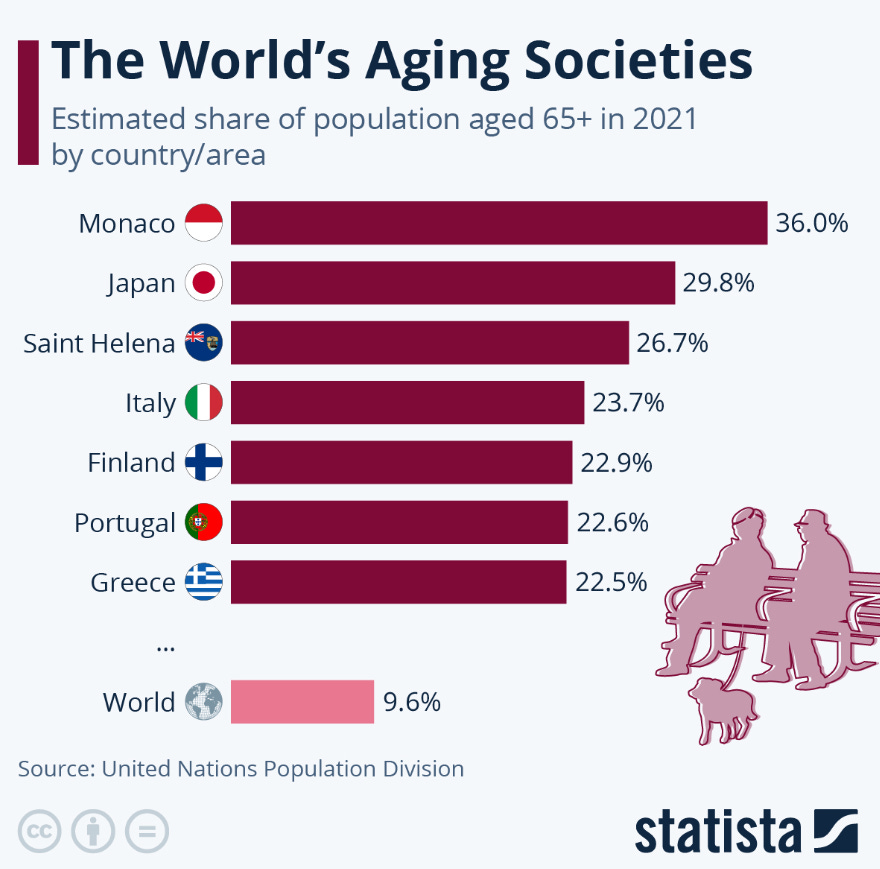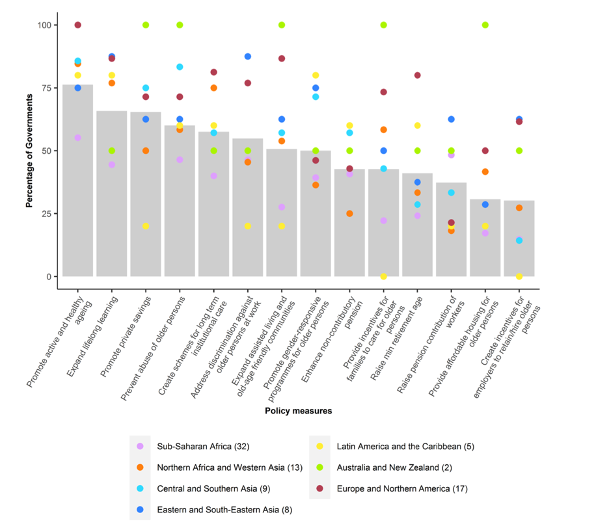The emergence of advanced healthcare technologies and continuous public health efforts, which include health-related education and awareness, have substantially improved living standards and life expectancy. For example, in the United States, life expectancy increased 3.3 years from 1990 to 2015.1 In recent years, the focus has however shifted towards healthspan, indicating the number of years people live without chronic diseases that affect their quality of life. Furthermore, the gap between healthspan and lifespan is approximately 9 years, suggesting that people tend to suffer from illnesses in the last decade of their life.2 Therefore, disease-free longevity is an important step towards healthy aging as global population substantially super-age in the coming decades.
Super-aged Societies
Multiple factors including enhancement in technologies and living standards have contributed to substantial improvements in lifespan. However, world population is aging faster than in the past. The World Health Organization (WHO) has also laid out strategic plans in its Sustainable Development Goals to accommodate rising numbers of aging population.3 By 2050, aging population defined by people over the age of 60 is expected to double and will make up 22% of global population.4 In the context of super-aged societies, Japan is typically the country that attracts the most attention as one in every 10 Japanese is aged 80 or older.5 Though South Korea does not face the challenges of a super-aged society, its low fertility rate may potentially lead to similar problems in the coming decades. Similarly, China is experiencing negative population growth, which may also result in aging-related issues. As a result, these countries have engaged with healthcare experts and policymakers to address current and coming challenges pertaining to super-aged societies.
To address the aforementioned challenges, the United Nations (UN) advises on direct interventions through government policies.6 In multiple regions, direct government interventions including healthy aging, lifelong learning, elderly abuse prevention, and institutional schemes for long term care have been adopted to promote longevity and healthy aging.2 Aside from policy-centered interventions, emerging healthcare technologies and other interventions also play a pivotal role in preparing for aging population. For instance, dietary and fitness regimens suggested by nutritionists and evidence-based elderly care from digital health innovation may help guide strategies that properly identify and address different challenges. To sum it up, step towards healthy aging is a multi-disciplinary effort that engages policymakers, research scientists, clinicians, nutritionists, public health experts, and many other stakeholders.
The Longevity industry will dwarf all other industries in both size and market capitalization and will require unprecedented sophistication to optimize opportunities.
Margaretta Colangelo
Credit: Statista/United Nations/World Economic Forum.4
Credit: United Nations – Department of Economic and Social Affairs.6
Government-funded Programs for Healthy Aging
In this section, we discuss a few examples of policy-cenetered interventions to promote healthy aging and preventive care for aging population.
HealthierSG (Singapore)7
Eligibility: Singaporeans >40 years old
Overview: Elderlies tend to develop chronic conditions along with other conditions including disabilities. Healthy lifestyle and habits may help elderlies improve quality of life and better manage existing conditions. Furthermore, access to medical resources also contributes to healthy aging.
Benefits
1. Support from clinical team
2. Healthy lifestyle activities
3. Personalized health plan
4. Fully subsidized screenings/vaccinations
5. Access to affordable medications
National Prevention Strategy (United States)8
Overview: It is the US effort to transition from sick care to strategies based on wellness and prevention. The aim is to build a healthy environment that improves preventive care services. Importantly, this effort also includes promoting healthy activities and eliminating health disparities in the United States.
Priorities
1. Healthy and Safe Community Environments
2. Clinical and Community Preventive Services
3. Elimination of Health Disparities
4. Tabacco Free Living
5. Preventing Drug Abuse and Excessive Alcohol Use
6. Healthy Eating and Active Living
7. Reproductive and Sexual Health
8. Mental and Emotional Well-Being
Health Care for the Elderly (Hong Kong SAR, China)9
Overview: To address aging population in Hong Kong, the government has set up various services for the elderly to stay active and healthy.
Health Advice and Disease Prevention
1. Health Centres and Hospitals Targeted the Elderly
2. Fitness programs for senior citizens
3. Dietary recommendations
4. Healthy lifestyles
5. Carer’s Corner: providing tips/skills for taking care of elderly
6. eElderly: portal for all services including healthcare for senior citizens
Advanced Healthcare Technologies towards Healthy Aging
On the policy level, governments like Singapore are actively putting in efforts to promote healthy aging. The emergence of advanced technologies has also resulted in markedly improved approaches to address healthy aging. Examples include:
1. Biomarker discovery for longevity
2. Therapeutics for healthy aging
3. Wearables that promote healthy lifestyles and behavior change
In the subsequent blog post series, each of the above-mentioned approaches will be discussed in detail.
References
Buxbaum, J. D., Chernew, M. E., Fendrick, A. M., & Cutler, D. M. (2020). Contributions Of Public Health, Pharmaceuticals, And Other Medical Care To US Life Expectancy Changes, 1990-2015: Study examines the conditions most responsible for changing US life expectancy and how public health, pharmaceuticals, other medical care, and other factors may have contributed to the changes. Health Affairs, 39(9), 1546-1556.
Garmany, A., Yamada, S., & Terzic, A. (2021). Longevity leap: mind the healthspan gap. NPJ Regenerative Medicine, 6(1), 1-7.
World Health Organization. (2022). Aging and Health. World Health Organization. https://www.who.int/news-room/fact-sheets/detail/ageing-and-health
Madeleine North. (2023). With life expectancy increasing, here’s how 4 countries are addressing their ageing populations. World Economic Forum. https://www.weforum.org/agenda/2023/09/life-expectancy-countries-ageing-populations/
Harvard T.H. Chan School of Public Health. (2024). Grappling with Japan’s super-aging society. Harvard T.H. Chan School of Public Health. https://www.hsph.harvard.edu/news/features/hana-hayashi-aging-japan/#:~:text=Japan%20is%20the%20most%20rapidly,but%20it%20comes%20with%20challenges.
United Nations. (2020). Government policies to address population ageing. United Nations. https://www.un.org/development/desa/pd/sites/www.un.org.development.desa.pd/files/undesa_pd_2020_pf_government_policies_population_ageing.pdf
HealthierSG. Ministry of Health, Singapore. https://www.healthiersg.gov.sg
U.S. Centers for Disease Control and Prevention. National Health Initiatives, Strategies & Action Plans. CDC. https://www.cdc.gov/public-health-gateway/php/communications-resources/national-health-initiatives-strategies-action-plans.html?CDC_AAref_Val=
GovHK. Health Care for the Elderly. GovHK. https://www.gov.hk/en/residents/health/healthadvice/healthcare/elderlyhealth.htm#:~:text=The%20Elderly%20Health%20Centres%20of,as%20members%20of%20these%20centres.




